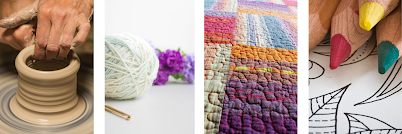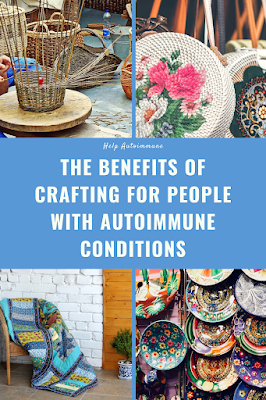There are many reasons why crafting is beneficial for people with autoimmune disease and in fact all chronic illnesses. Here I uncover some of the research which confirms what many crafters feel when they do their favorite pastime whether it is drawing, pottery, baking, scrapbooking, quilting, rock painting or whatever craft takes their fancy.
Crafting for many people is an enjoyable or relaxing experience and it may be associated with a freedom of expression and a sense of achievement.
Crafting is good for your mental health. Art therapists have known this for years. Their whole field is based upon the benefits of any form of art being beneficial in so many ways. A wide variety of studies have been done now to provide an understanding of these benefits. Some of the results have proven that:It can be a distraction from pain.
It can decrease anxiety, stress, and mood disturbances which are often felt by people with chronic conditions.
It can improve well-being and quality of life.
It can activate the reward pathways in the brain providing a sense of satisfaction.
RESEARCH INTO THE BENEFITS OF CRAFTING
A US university study even measured 39 participants' cortisol levels to monitor their stress from a session of creative crafting like collage and found a significant lowering of cortisol levels which means they were less stressed.
One
The findings of this study illustrate how creative craft hobbies such as quilting can be a meaningful vehicle for enhancing wellbeing. This study sets the foundation for further research into creativity, creative hobbies, and hobbies in general. A range of cognitive, emotional, and social benefits were uncovered that participants attributed to quilting that could be seen by all crafts.
A 2018 study shows that crafting is calming, promotes successful aging, and has long-term social and cultural benefits. Researchers found four factors common in their older crafting community: (1) identity, (2) spirituality, (3) calming and (4) mastery/recognition from others led to less decline in everyday functioning and independence among older adults.
A study into the simple act of doodling proved that it aided concentration, improved visuomotor learning, and decreased boredom. Ways of maintaining attention to task are also important in the context of depressive ruminations and worry.
Many people, with autoimmune conditions, have found that they now have reduced skills such as fine motor hand skills or eye problems and they may need to change or modify their hobbies. I personally use to do fine and detailed etching in metal but have changed to coloring due to decreased hand strength. I still enjoy having an activity that I can do that provides me with a sense of creativity and distraction from my symptoms. A friend was telling me she use to do pottery but now due to limited space and the inability to drive to the local kiln to have her pots fired, she has swapped to polymer clay which can do at home.
MAKING CRAFTING EASIER
Pastel or charcoal drawing using larger crayons may be easier when you have lost dexterity in your hands.
Collage creations with torn paper and glue sticks rather than using scissors.
Create art, as simple as dots, on pre-cut cards and envelope sets. The same can be done on blank postcards.
A table easel may make painting or drawing more accessible but it is a matter of personal preference.
Large crayons and triangular colored pencils designed for easy grip by children may help some people with dexterity or strength issues.
Some people like painting on material rather than paper.
QUESTIONS ABOUT CRAFTING FOR YOU
Are you someone who loves crafting and feel that they gain great benefits in having a hobby or passion that you enjoy? It would be wonderful if you could tell us what hobby you enjoy and a bit about it in the comments. Thank you.
Are you someone that has always been a crafter and has had to modify the way they craft or the type of crafts they do? We would love to hear from you too.
SOURCES MENTIONED:
- Adams-Price CE, et al. (2018). Crafts as serious hobbies: Impact and benefits in later life.
ingentaconnect.com/content/intellect/crre/2018/00000009/00000001/art00006 - Andrade J. (2009). What does doodling do?
- onlinelibrary.wiley.com/doi/abs/10.1002/acp.1561
- Burt EL, et al. (2012). The relationship between quilting and wellbeing.
academic.oup.com/jpubhealth/article/34/1/54/1550848 - Ferrarese CL. (2018). Women's perceptions of flourishing through quilting as a leisure activity.
scholarworks.waldenu.edu/dissertations/6201/ - Kaimal G, et al. (2015). Crafting, health, and wellbeing: Findings from the survey of public participation in the arts and considerations for art therapists.
tandfonline.com/doi/full/10.1080/17533015.2016.1185447 - Kaimal G, et al. (2016). Reduction of cortisol levels and participants’ responses following art-making.
tandfonline.com/doi/full/10.1080/07421656.2016.1166832







No comments:
Post a Comment